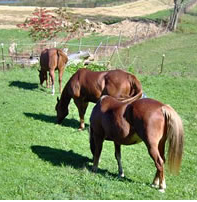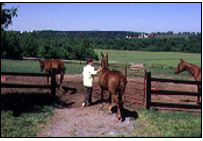Home > Horse Care > Farm and Barn > EQUUS Consultants: Exercising options
EQUUS Consultants: Exercising options
- July 25, 2019
- ⎯ Equus
Question: I am considering buying a property that is currently divided into rotational grazing spaces for cattle. If we do purchase it, what size of individual paddocks would be optimal for horses? What is the minimum herd size of mares and older foals, yearlings and 2-year-olds for optimum exercise? What can I do, besides putting the shed and water source apart from feeding areas to increase self-exercise while the horses are out?

Answer: When purchasing a horse property, you need to consider three things: the available and sustainable nutrient production, the land’s topography and the geographic layouts of potential paddocks.
Most permanent, improved pastures in the United States will thrive, with good agronomic practices, unless they are stocked with more than one horse for every two acres. Three acres per horse is better, and five is a real luxury. These acreage estimates hold true when talking about optimizing exercise as well.
If the terrain is flat and the footing reliable, horses can frolic away their excess energy in any shape enclosure, provided there is enough acreage per horse. If the terrain is steeply rolling or has poor or hazardous footing then the best option is to set up long, narrow paddocks with water at one end and other attractions, such as food, shelter or shade, at the other to encourage more voluntary exercise with less risk of injury.

Self-exercise is simply play and to encourage it, you may need to experiment with different herd sizes. Equine herds can include just a couple of horses, but for horses to have a more active lifestyle, having four to eight is a good number. Larger herds tend to divide into two or more bands or cliques of preferred associates or familial networks, which function as small herds.
If your space won’t meet your ideals, you can hand-walk the older foals and yearlings for exercise or, better yet, have them follow an older, ridden horse at liberty. However, be careful to avoid overtiring a youngster following you as you ride: When the younger horse starts to lag behind, you know his safe tolerance for exercise has been met and a couple days of rest will have him ready for more.





